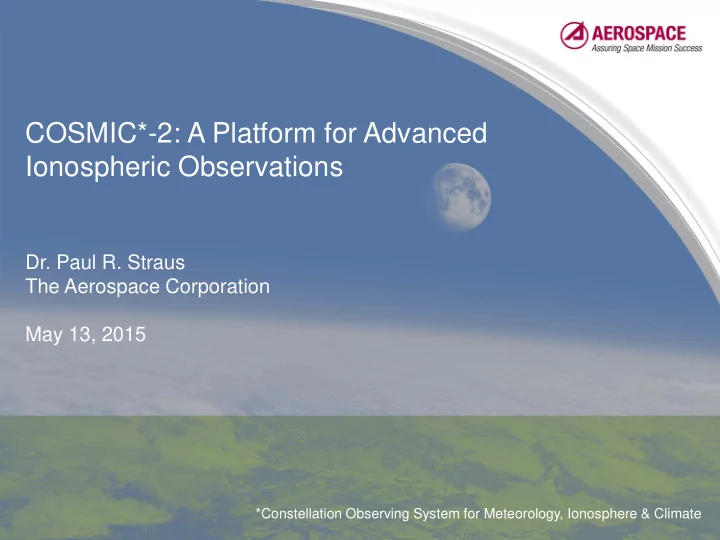

COSMIC*-2: A Platform for Advanced Ionospheric Observations Dr. Paul R. Straus The Aerospace Corporation May 13, 2015 *Constellation Observing System for Meteorology, Ionosphere & Climate
The COSMIC-2 Partnership Organization Responsibilities • 12 Spacecraft (From SSTL) Taiwan NSPO • Command & control (1 ground site) • Secondary sensors for polar SVs • Lead US agency • COSMIC-2 ground sites NOAA • TGRS ground processing • TGRS sensors for polar SVs • All sensors for equatorial SVs • Launch USAF • RF Beacon ground system • RF Beacon/IVM ground processing • TGRS TriG Electronics Development at JPL NASA • The COSMIC-2 constellation – 6 satellites at 24° inclination (Launch in May 2016) – 6 satellites at 72° inclination (FY18 launch) – not yet fully funded
TGRS POD The COSMIC-2 Spacecraft Antenna IVM TGRS RO Antenna RF Beacon Antenna The COSMIC-2 spacecraft are being developed by Surrey Satellite Technologies Limited (SSTL) Under Contract to Taiwan’s National Space Agency Graphic courtesy SSTL
COSMIC-2 (Equatorial) Launch & Deployment Altitude (km) Graphic courtesy NSPO Graphic courtesy SSTL Time (weeks) • COSMIC-2 (equatorial) is the co-primary payload on the STP-2 mission • Falcon Heavy vehicle out of Cape Canaveral • 6 COSMIC-2 spacecraft on two ESPA-Grande-like rings • Initial altitude: 700 km • Final altitude: 520 km (closer to F-region peak) achieved w/ on-board propulsion • Differential orbit precession separates the orbit planes, resulting in a uniformly spaced constellation
Equatorial Ionospheric Science • COSMIC-2 will provide data that will significantly enhance operational space weather products and also improve understanding of the equatorial ionosphere • Two focus areas – Large & medium scale ionospheric structure • Plasma density distribution is driven by – Production and loss mechanisms – Neutral composition – Plasma transport caused by electric field and neutral winds • Research focus: improvements to advanced assimilative specification models – Small scale structures • Plasma instabilities generate turbulent “bubble structures” containing irregularities that cause ionospheric scintillation • Instability regions “live within” the larger scale ionospheric background and are affected by E-fields and winds • Research focus: provide a complete specification of global irregularity regions to improve understanding of this phenomena – Both areas are affected to atmospheric coupling from below
TGRS GNSS Radio Occultation Sensor • Special purpose receiver tracks POD Antennas GPS & GLONASS satellite signals to measure carrier phase, pseudorange, and SNR • Derived parameters – Limb & upward looking TEC – L-band scintillation – Tropospheric/stratospheric bending angle & refractivity Electronics • Key inputs for both ionospheric and terrestrial weather models RO Antennas Sample Single Orbit Coverage (C/NOFS) TGRS pictures courtesy JPL C/NOFS Orbit 800 Altitude (km) S4 400 Ionospheric Scintillation Regions Day Night 0 Occultations Electron Density Scintillation Graphic courtesy AFRL
IVM image courtesy UTD IVM In-Situ Sensor • IVM employs gridded electrostatic Plasma Density analyzers designed to observe & Fluctuations characterize in-situ plasma SatCom/GPS • Key observations include plasma drifts Satellite (E-fields), density, and irregularity region locations • In-situ observations near F-region peak drive COSMIC-2 (eq.) 520 km altitude Irregularities in Ionosphere In-Situ Scintillation, observation Climo comm dropouts, GPS loss of lock Receiver Model w/ E-field Graphics courtesy AFRL
RF Beacon Sensor • Ground-based receivers measure RF Beacon signals (amplitude & phase) to determine scintillation environment – 400, 965, 2200 MHz signals Beacon Data • Ancillary two-frequency TEC measurements provide data for ionospheric assimilative models • Coupling North-South morphology of irregularity regions with East-West geometry of COSMIC-2 (Equatorial) orbit enables better scintillation Graphic courtesy AFRL region mapping (relative to polar orbits) Potential RF Beacon Ground Sites 30N 0 30S Beacon Antenna Graphic courtesy AFRL Electronics Unit Unit RF Beacon drawing/picture courtesy SRI
Ionospheric Characterization Via Assimilative Modeling TEC lines of sight Model Voxel • COSMIC-2 (eq) will provide exceptional low latitude ionosphere coverage/refresh – TGRS: limb and overhead TEC – IVM: in-situ density & E-fields – RF Beacon: regional TEC • Coverage analysis assumptions – Evaluation of ability to “populate” an assimilative model – 1°×2.5°×20-50 km voxel granularity (lat. × long. × alt.) TGRS+IVM (In- Situ Density) – IVM exactly specifies voxel density COSMIC-2 – TGRS TEC data for tomographic-like reconstruction • Require two observations through a voxel to be considered fully specified • “Data utility scoring” approach weighs LOS passing through much of a voxel more heavily than those “skirting” a voxel Free-Flyer – Analysis region: ±30° geomagnetc latitude/100-800 km altitude, bounded by 300 km field lines at ±30° 24-Hour coverage graphic courtesy UCAR 24-Hour LOS Limb TEC Coverage COSMIC-2 Free-Flyer IVM (E-Fields) Bulk Ionosphere Evolution Time Scale: ~60 min.
Scintillation Region Characterization COSMIC-2 • The IVM will provide detailed Free-Flyer information regarding 18 Aug 2008 localization of irregularity RF Beacon regions on timescales associated with their evolution • The RF Beacon provides a COSMIC-2 precise characterization of scintillation behavior in regions Scintillation Evolution with ground sites, augmented Time Scale: 15-30 minutes by limb L-band observations Free-Flyer from TGRS Graphic courtesy AFRL TGRS COSMIC-2 Free-Flyer IVM RF Beacon Spatial (Depletions) Coverage Figure from Huong, et. al., JGR , doi: 10.1029/2010JA015982 (2011).
Example RO Scintillation MAP (C/NOFS) PLP S4 Events CORISS S4<0.025 CORISS S4>0.025 Occultation Tangent Point Tracks C/NOFS Orbit Track 90° SZA 100° SZA
Summary • The COSMIC-2 program is on track to launch six satellites into low inclination orbits in 2016 • The sensor complement on these satellites will provide unprecedented coverage and refresh to support operational space weather applications and to advance scientific understanding of equatorial ionospheric structure & irregularities All trademarks, service marks, and trade names are the property of their respective owners
Recommend
More recommend